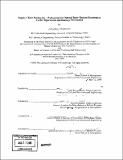Supply chain packaging : packaging for optimal inter-region distribution center operations and damage prevention
Author(s)
Obatoyinbo, Adesunloye
DownloadFull printable version (7.292Mb)
Alternative title
Packaging for optimal inter-region distribution center operations and damage prevention
Other Contributors
Leaders for Manufacturing Program.
Advisor
Oral Buyukozturk and Don Rosenfield.
Terms of use
Metadata
Show full item recordAbstract
Honeywell International Corporation is a $27.5 billion [1] conglomerate with a diverse portfolio of businesses covering Aerospace, Automation and Controls, Specialty Materials and Transportation. Honeywell's Automation and Controls Solutions (ACS) business is the second largest business group with $9.4 billion in sales in 2005. This business group is further divided into the following strategic business units: * Security (Facilities) * Life Safety * Building Solutions * Process Solutions * Sensing and Control * Environmental and Combustion Controls The Environmental and Combustion Controls (ECC) business unit of Honeywell ACS maintains a global manufacturing and distribution presence. ECC delivers complex systems that control air, water and combustion for both homes and industrial customers. Historically, ECC plants in the EMEA (Europe, Middle East and Africa) region have either had their own warehouses or had a captive third party provider that provided warehousing services offsite. However, recent initiatives in the region have culminated in the adoption of a regional distribution center model. Essentially, clusters of plants are grouped into regions that are served by the same warehouse or distribution center. (cont.) The regional warehouse in Heilbronn Germany (ERD) is the pilot for such a system. Plants in Emmen in the Netherlands, Brno in the Czech Republic, Nagykanisza in Hungary and Schoenaich and Mosbach in Germany, as well as some small Low Risk Distribution (LRD) centers - which stock emergency volumes - in western Europe will all be consolidated and served from the distribution center in Heilbronn. This essentially means that instead of storing their own inventory, all the affected plants will truck all production to the Heilbronn warehouse on a daily basis. The Heilbronn warehouse, which commenced operation in May, 2005 subsequently fulfills all customer orders associated with the locations listed above. During the consolidation exercise, while planning for receipt of goods from the different plants, it became clear that there were multiple packaging standards in use throughout Europe. There thus arose the need to consolidate the different standards into a coherent well-defined standard to enable the new distribution center established at Heilbronn, Germany, to properly handle goods from the different plants. (cont.) Additionally, the newly built ERD had a need for an established set of packing guidelines that may include procedural changes or the establishment of new procedures, changes to the physical setup of the outbound lines (freight and parcel), presentation and replenishment of packaging material and suggestions for improvement for the long term. Receiving guidelines have also been newly instituted for products arriving at the ERD, which also creates a case for compliance for goods being shipped from suppliers including a counterpart warehouse - the Louisville Distribution Center (LDC) - in Louisville, Kentucky. In addition, the LDC had been having difficulty receiving freight from the European plants. The major problems included inadequate labeling, lack of overpacking, inconsistency in packing of mixed pallets and the non-usage of Honeywell 40" X 32" pallets. Since all European plant shipments that formerly shipped directly from each plant would be shipping from ERD in Heilbronn going forward, it became imperative that appropriate packaging standards be developed (in Europe) in order to ensure compliance with receiving guidelines in Louisville at the LDC. Fulfillment through the distribution centers is what drives customer satisfaction. (cont.) No matter how efficient the plants may be, transit through the distribution centers is the proverbial "last mile" that delivers all the efforts of the firm to the customers. I have developed and recommended a packaging standard, which outlines the levels to which packaged products must be tested in preparation for safe shipping. I analyzed current packing practice at the ERD showing relevant cost drivers and made recommendations on ways to pack in order to improve service to the downstream distribution center while keeping costs contained. I developed a framework to guide warehouse management with regards to pallet shipping decisions between the ERD and LDC. Finally, I developed a carton replenishment framework for the ERD that can be adopted for other appropriate ECC warehouses.
Description
Thesis (M.B.A.)--Massachusetts Institute of Technology, Sloan School of Management; and, (S.M.)--Massachusetts Institute of Technology, Dept. of Civil and Environmental Engineering; in conjunction with the Leaders for Manufacturing Program at MIT, 2006. Includes bibliographical references (p. 65).
Date issued
2006Department
Leaders for Manufacturing Program at MIT; Massachusetts Institute of Technology. Department of Civil and Environmental Engineering; Sloan School of ManagementPublisher
Massachusetts Institute of Technology
Keywords
Sloan School of Management., Civil and Environmental Engineering., Leaders for Manufacturing Program.